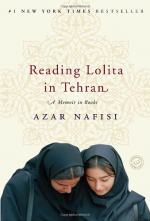
|
| Name: _________________________ | Period: ___________________ |
This test consists of 15 multiple choice questions and 5 short answer questions.
Multiple Choice Questions
1. In Part 4, Chapter 24, why do the girls have to sit in the back room of the restaurant?
(a) The girls can remove their head scarves if they sit in the back room.
(b) Unaccompanied women are not allowed to sit in the main section.
(c) Only men are permitted in the main section.
(d) The cafe is too small to accommodate the large group in the front.
2. In Part 4, Chapter 20, what does Nassrin decide to do?
(a) Go to London to live with her sister.
(b) Get divorced.
(c) Stay in Iran.
(d) Get married.
3. In Part 3, Chapter 13, what does Nafisi get on the first day she begins teaching?
(a) A visit from the religious leaders.
(b) A bouquet of flowers.
(c) A cup of coffee from her mother.
(d) An obscene message.
4. Why does Professor R. continue to participate in vigils at the University of Tehran after he resigns from his position?
(a) He believes that the university needed to know how strongly he felt about his actions.
(b) He wants his students to see him as a political figure and an inspiration for their own political choices.
(c) He is angry with the university's decision to change the curriculum, and wants to punish the leaders for their decision.
(d) He wants his students to know he did not leave because he was afraid the government would persecute him.
5. What does Mr. Forsati want to do?
(a) Write a novel about life in Iran.
(b) Work as an official in the Iranian regime.
(c) Marry one of Nafisi's students.
(d) Start a company related to videos and films.
6. How does Nafisi describe the Iranian perception of America?
(a) As mythical, combining elements of Satan and Paradise Lost.
(b) As realistic, exposing the immorality of Western culture.
(c) As sad, forcing her to change her way of thinking.
(d) As encouraging, signalling their renewed interest in Western thought.
7. What does Nafisi describe in the epilogue?
(a) The memories of her former students who were executed.
(b) How she made the decision to leave Iran.
(c) Her journey to America.
(d) The activities of her former students after Nafisi left Iran.
8. Who is Mr. Bahir?
(a) The department chair of the Language Department at the University of Tehran.
(b) The owner of her favorite bookstore.
(c) A man executed for charges of being too Westernized.
(d) One of Nafisi's students.
9. What game does Nafisi play when she begins wearing a black robe?
(a) She pretends that nothing has changed, and she is not wearing a robe.
(b) She pretends that everyone can see her as a human being.
(c) She pretends she is a religious leader and has additional authority.
(d) She pretends her whole body disappears, and she becomes invisible.
10. What do Nafisi and the magician share on their first meeting in his apartment?
(a) Tea and a box of foreign chocolates.
(b) Newspapers from foreign countries.
(c) Coffee and books.
(d) A foreign movie.
11. What does Nafisi notice is missing from the walls at the university?
(a) Political slogans.
(b) Notices about proper conduct and attire.
(c) Notices about films, talks, and books.
(d) Pictures of political leaders.
12. What political event described at the beginning of Chapter 9 sets the tone for the subsequent actions of Nafisi's students?
(a) The student occupation of the American Embassy in Tehran.
(b) The arrest of a popular professor for refusing to follow the regime's laws.
(c) The invasion of Iran by Iraq.
(d) The overthrow of the leadership of the University of Tehran.
13. What does Nafisi emphasize in the introductory course she teaches in Part 3?
(a) The ways novels change ideas about relationships between individuals.
(b) The ways novels present women in Western culture.
(c) The ways novels emphasize religious and cultural values.
(d) The ways novels are similar to contemporary life.
14. What teaching technique does Nafisi use in conjunction with the study of "The Great Gatsby"?
(a) She teaches the novel using the Socratic method, which the students have never seen before.
(b) The class puts the novel on trial, choosing people to play the roles of lawyers, judge, and jury.
(c) She chooses students to lead the class discussion.
(d) Nafisi asks the students to construct character sketches of the novel's main characters and compare the sketches to their own lives.
15. Why does Nafisi say the dream in "The Great Gatsby" is not a comment on America as a materialistic county?
(a) Because the novel does not include any rich characters.
(b) Because the dream is about what one can become, not about money.
(c) The dream represents Nick's inability to be honest as a narrator.
(d) Because "The Great Gatsby" is about wanting to be richer than your neighbors.
Short Answer Questions
1. What gift does Nafisi give to the magician?
2. What happens to Nassrin after she leaves Iran?
3. In Part 3, Chapter 9, what author does Nafisi discuss with the magician?
4. What does the study group find disturbing about the texts written by the Ayatollah Khomeini?
5. Why do the students begin to keep vigils at the University of Tehran?
|
This section contains 922 words (approx. 4 pages at 300 words per page) |

|




